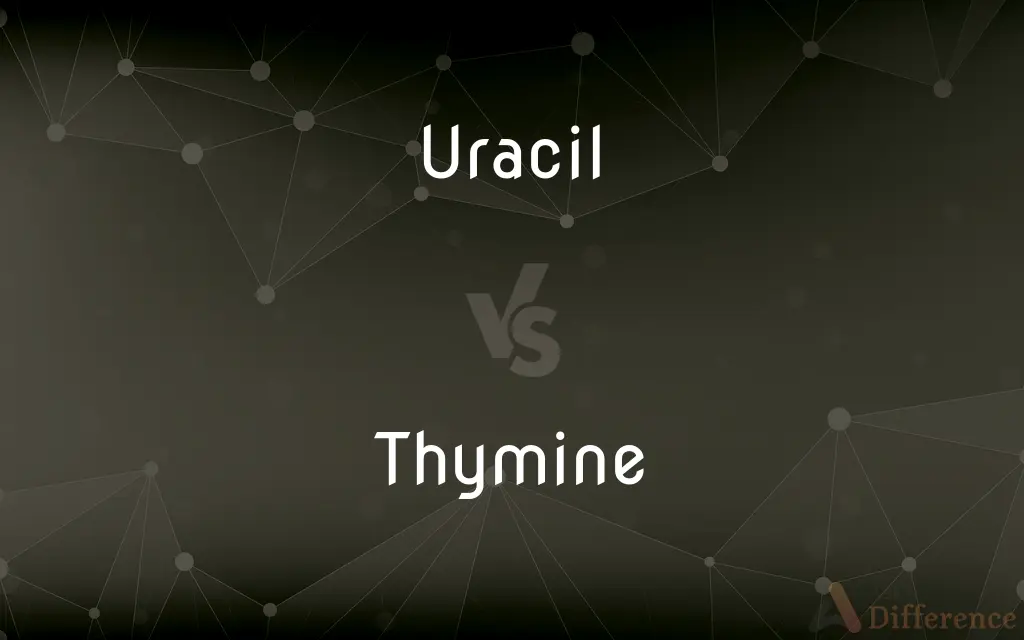Uracil vs. Thymine — What's the Difference?
By Urooj Arif & Maham Liaqat — Updated on April 17, 2024
Uracil is a nucleobase found in RNA that pairs with adenine, while thymine, exclusive to DNA, pairs similarly but includes a methyl group that distinguishes it from uracil.

Difference Between Uracil and Thymine
Table of Contents
ADVERTISEMENT
Key Differences
Uracil is one of the four nucleobases used in the structure of RNA, where it pairs with adenine through hydrogen bonding. In contrast, thymine is used instead of uracil in DNA, also pairing with adenine but characterized by its additional methyl group at the 5-carbon in its ring structure.
While uracil lacks the methyl group present in thymine, this small structural difference significantly impacts the stability and functional roles of RNA and DNA. Thymine's extra methyl group makes DNA more chemically stable and less susceptible to mutation than RNA.
In biochemical processes, uracil's ability to bind with adenine is similar to that of thymine; however, the presence of thymine in DNA instead of uracil is thought to be an evolutionary adaptation to improve the efficiency of error-checking during DNA replication. This adaptation helps prevent the incorporation of uracil, which can occur through the deamination of cytosine and lead to base-pair mismatches.
Thymine can undergo hydrolytic deamination to become uracil, a change that DNA repair enzymes can recognize and correct, thus protecting the genetic integrity. In contrast, since RNA is more transient and not used for long-term genetic storage, the presence of uracil does not pose the same risk of mutation.
Despite these differences, both uracil and thymine play crucial roles in the genetic code of organisms uracil being central to RNA's role in protein synthesis and gene regulation, and thymine in maintaining the genetic stability of DNA.
ADVERTISEMENT
Comparison Chart
Found In
RNA
DNA
Chemical Structure
Lacks a methyl group at the 5-carbon position.
Contains a methyl group at the 5-carbon position.
Pairing
Pairs with adenine.
Pairs with adenine.
Role
Involved in protein synthesis and gene regulation.
Helps in genetic stability and DNA replication.
Mutation Susceptibility
More susceptible to mutations.
Less susceptible due to error-checking mechanisms.
Compare with Definitions
Uracil
Uracil is a pyrimidine nucleobase in RNA that pairs with adenine.
During transcription, adenine in DNA pairs with uracil in RNA.
Thymine
Thymine is a pyrimidine nucleobase found in DNA, pairing with adenine.
In DNA's double helix, thymine and adenine are connected by two hydrogen bonds.
Uracil
Uracil's structure makes RNA less stable and more reactive than DNA.
The absence of a methyl group in uracil contributes to RNA's shorter lifespan in cells.
Thymine
DNA replication fidelity is partly ensured by the presence of thymine.
Thymine checks and prevents errors by distinguishing from uracil.
Uracil
Unlike DNA, RNA uses uracil instead of thymine to carry genetic information.
Uracil is essential for the proper synthesis of proteins as directed by RNA.
Thymine
Thymine is only found in DNA and is essential for long-term genetic storage.
Thymine's stability is crucial for accurately transmitting genetic information.
Uracil
Uracil can be chemically converted to other bases under certain conditions.
Cytosine deamination can mistakenly produce uracil in DNA, leading to errors.
Thymine
Thymine contributes to the structural integrity and stability of DNA.
The methyl group in thymine helps protect DNA from UV damage.
Uracil
In RNA, uracil plays a role in the regulation of gene expression.
Uracil-rich sequences can help stabilize certain RNA molecules.
Thymine
Thymine can undergo mutations, which DNA repair mechanisms can correct.
Thymine dimers formed by UV light are repaired to prevent skin cancer.
Uracil
Uracil (; U) is one of the four nucleobases in the nucleic acid RNA that are represented by the letters A, G, C and U. The others are adenine (A), cytosine (C), and guanine (G). In RNA, uracil binds to adenine via two hydrogen bonds.
Thymine
Thymine (T, Thy) is one of the four nucleobases in the nucleic acid of DNA that are represented by the letters G–C–A–T. The others are adenine, guanine, and cytosine. Thymine is also known as 5-methyluracil, a pyrimidine nucleobase.
Uracil
A pyrimidine base, C4H4N2O2, that is an essential constituent of RNA.
Thymine
A pyrimidine base, C5H6N2O2, that is an essential constituent of DNA.
Uracil
(organic compound) One of the bases of RNA, pairing with adenine.
Thymine
A heterocyclic base, 5-methylpyrimidine-2,4(1H,3H)-dione; it pairs with adenine in DNA.
Uracil
A nitrogen-containing base found in RNA (but not in DNA) and derived from pyrimidine; pairs with adenine
Thymine
A base found in DNA (but not in RNA) and derived from pyrimidine; pairs with adenine
Common Curiosities
How does the presence of thymine in DNA contribute to genetic stability?
Thymine's additional methyl group increases DNA's chemical stability and reduces the risk of mutations, thus ensuring genetic fidelity.
What would happen if thymine were replaced by uracil in DNA?
If DNA contained uracil instead of thymine, it would be more prone to errors and instability, as uracil can result from cytosine deamination, leading to base-pair mismatches.
What is thymine?
Thymine is a nucleobase in DNA that pairs with adenine, crucial for DNA's structural stability and integrity.
Can thymine be found in RNA?
No, thymine is exclusively found in DNA, while RNA contains uracil in its place.
Why does RNA use uracil instead of thymine?
RNA uses uracil because it is less stable and more suitable for RNA's temporary and rapid-turnover roles in cells.
How are uracil and thymine structurally different?
The main structural difference is the presence of a methyl group at the 5-carbon position in thymine, which uracil lacks.
What is uracil?
Uracil is a nucleobase found in RNA that pairs with adenine and is essential for RNA's role in protein synthesis and gene regulation.
What is the function of uracil in RNA?
Uracil functions as a base that pairs with adenine during RNA transcription and plays a role in gene expression and regulation.
What role does uracil play in genetic mutations?
Uracil can lead to mutations if it is incorporated into DNA, as it can arise from deamination of cytosine and pair incorrectly during replication.
What are the effects of UV light on thymine and uracil?
UV light can cause thymine dimers in DNA, which are repaired to prevent mutations, whereas uracil is not typically affected by UV in the same way.
Can uracil be artificially introduced into DNA?
Yes, uracil can be incorporated into DNA in laboratory settings, often used in research and biotechnological applications to study DNA repair and mutation processes.
How do repair mechanisms address thymine-related mutations?
DNA repair mechanisms, such as nucleotide excision repair, can recognize and correct thymine dimers and other thymine-related mutations to prevent errors.
What are the implications of uracil’s susceptibility to mutation?
Since RNA is not used for long-term genetic storage and is constantly being synthesized and degraded, uracil's susceptibility to mutation is less critical compared to DNA.
How do cells distinguish between uracil and thymine during DNA replication?
Cellular mechanisms specifically recognize thymine in DNA and can identify and repair uracil if it mistakenly appears in DNA, thus maintaining genetic accuracy.
Why is thymine considered more evolutionarily advantageous in DNA than uracil?
Thymine's chemical stability and the ability to undergo error-checking processes make it more advantageous for the long-term storage of genetic information in DNA.
Share Your Discovery

Previous Comparison
Enterprise vs. Corporate
Next Comparison
Parapet vs. RailingAuthor Spotlight
Written by
Urooj ArifUrooj is a skilled content writer at Ask Difference, known for her exceptional ability to simplify complex topics into engaging and informative content. With a passion for research and a flair for clear, concise writing, she consistently delivers articles that resonate with our diverse audience.
Co-written by
Maham Liaqat














































